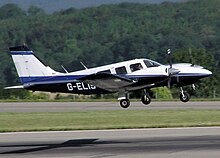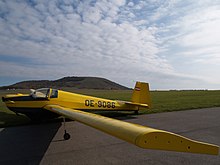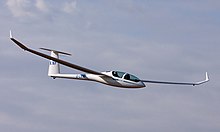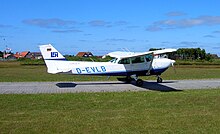Light aircraft
As a light aircraft or small aircraft are different aircraft of various classes, but low weight referred to sometimes turn into media reports and twin-engine aircraft up to 5.7 tons take-off weight. According to the classification of the International Civil Aviation Organization on the airworthiness aircraft over 5.7 t take-off weight than large aircraft ( English Large Airplane ) considered for an extensive approval is required. Pilots often require a type rating for large aircraft. In the United States, the Federal Aviation Administration places the weight limit on aircraft at 12,500 lb., which is 5670 kg.
Aircraft in the weight segment up to 5.7 t take-off weight are mainly used by general aviation .
Classification
The following classification is largely based on the classification of the individual ratings in the official pilot licenses. All abbreviations come from this system.
SEP

"Single Engine Piston" aircraft are single-engine, piston-engine- powered aircraft. There is no weight limit for the maximum takeoff weight . To fly these aircraft, a pilot needs a SEP rating . Examples would be the Antonow An-2 , Cessna 172 , Cirrus SR20 or Piper PA-28 .
SET

"Single Engine Turbine" - single-engine, turboprop- powered aircraft. For this purpose, pilots need a SET rating. Typical representatives of the SET class are for example the Cessna 208 , Piper PA-46 , Pilatus PC-12 , or Socata TBM 700 .
MEP

“Multi Engine Piston” - these are multi-engine, piston-engine- powered aircraft. Pilots need an ME (P) rating for this. Typical representatives of the MEP class are for example the Cessna 310 , Piper PA-34 or Tecnam P2006T .
ME
In this case, “multi engine” also refers to multi- engine aircraft , but not piston engine- powered aircraft. So it concerns all other types of drive that are used, z. B. Turboprop or jet engines . The ME class includes the MEP class. Aircraft such as B. the DHC-6 Twin Otter or the Beechcraft Super King Air B200 fall into this category, but also large aircraft such as the Airbus
HPA
"High Performance Aircraft" refers to aircraft that are permitted to be flown with a single pilot , but are similar in terms of their flight performance and the performance of their aircraft and navigation systems to aircraft types that are operated with a minimum crew of two pilots. Examples would be the Piper PA-46 or the Socata TBM 850 .
TMG

"Touring Motor Glider" are touring motor gliders up to a maximum of 850 kg MTOW . The European powered flight ticket can be purchased either with this or with the SEP rating. Touring motor gliders may, however, also be flown with the glider license after the authorization has been acquired. The most famous TMG is the SF 25 falcon . A more modern representative is the Super Dimona HK36 . Both are preferred in training.
Experimental
Experimental or individual pieces are light aircraft of different categories that are not certified by the manufacturer, but are approved for traffic by the builder as part of a construction-accompanying individual test. Kit aircraft such as B. Van's RV-4, various Pitts or Velocity are technically and administratively supported in Germany by the Oskar-Ursinus-Vereinigung . They are characterized by the fact that the builder must provide at least 51% of the work in the construction. Compared to certified samples, self-builders are exempt from some restrictions in terms of equipment and maintenance. However, restrictions on use can also be made in the traffic permit (no visual flight at night, avoidance of metropolitan areas and crowds). Replicas of historical aircraft, aerobatic aircraft or very individual design studies can also be found in this aircraft class.
VLA
In Europe, very light aircraft are single-engine powered aircraft that are approved according to the CS-VLA certification regulations. They must not have more than two seats, a flight weight of no more than 750 kg, and their stall speed must not exceed 45 knots . In return, the technical requirements - compared to those according to CS-23 - have been reduced somewhat, for example with regard to the approval of the engine and propeller. They can also be flown with only nationally valid pilot's licenses ( PPL-N ) (only within Germany). The Aquila A210 belongs to this light aircraft class .
Glider

Gliders are aerodynamically high-quality aircraft that are designed for flight without a motor. After taking off using a winch or tow plane, they fly in gliding flight. If they move through updrafts, they can gain new altitude there.
LSA
The Light Sport Aircraft (LSA) is a new class of aircraft in the United States since 2004 . Contrary to the existing regulations for type certification for light aircraft, the approval for the LSA class ASTM defines the rules. The rough rules for this class provide for a maximum speed with maximum engine power of 120 kts (222 km / h) and a maximum take-off weight of 1320 lbs (600 kg). Further cornerstones of the class are a piston engine , no pressurized cabin, propellers with a fixed pitch angle, a maximum of two seats and a fixed landing gear.
The US regulations were largely adopted in 2011 by the European Aviation Safety Agency as part of the standardized certification rules for light aircraft ( European Light Aviation 1 , ELA 1 ), which resulted in the certification standard CS- LSA. The LSA class in the EU was aimed at opening up the possibility for more powerful models of the ultralight aircraft classes to obtain easier approval as light aircraft.
Sportsters
These are single-engine light aircraft in the USA up to a weight of 560 kg.
Microlights
According to German regulations, ultralight aircraft (ULs) are motor-powered ultralight aircraft with a maximum take-off weight of 600 kg, including 25 kg for the entire rescue system . According to the definition of aviation law, these are air sports equipment and not aircraft. For this type of aircraft, less strict regulations apply in terms of licensing and maintenance than for larger aircraft classes. This makes UL flying relatively inexpensive and financially attractive. The limits of usability, however, are lower payloads than comparable one- and two-seat light aircraft. In addition, the licensing, the pilot's license for air sports equipment drivers and the registration of the aircraft are generally regulated nationally and are therefore only valid in Germany. Every flight abroad therefore requires a single permit or a binational agreement with the host country.
In the European Basic Regulation on aviation, ultralight aircraft are listed in Appendix I. In addition to certain framework conditions, it gives the individual member states of the EU the right to regulate the approval of UL aircraft nationally. There is therefore no standardization under European law and no mutual recognition.
history
In 1918/1919 the German aircraft pioneer Hanns Klemm constructed the first light aircraft out of wood.
Individual evidence
- ↑ Appendices to the Convention of the International Civil Aviation Organization (ICAO), Appendix 8: Airworthiness of Aircraft, Part III Large Airplanes
- ↑ CFR 14 Subcharter A Part 1. Electronic Code of Federal Regulations, accessed April 5, 2020 .
- ↑ Leaflet on testing and approval of self-made items in accordance with § 3 LuftGerPV (PDF) Luftfahrt-Bundesamt . May 2009. Accessed on March 13, 2012. ( Page no longer available , search in web archives ) Info: The link was automatically marked as defective. Please check the link according to the instructions and then remove this notice.
- ^ Lars Tolksdorf: The European LSA class . In: fliegermagazin . No. 08/2012 , August 1, 2012 ( fliegermagazin.de [accessed April 5, 2020]).
- ↑ EASA publishes another draft for ELA. In: www.daec.de. German Aero Club, April 25, 2008, archived from the original on May 20, 2008 ; accessed on April 5, 2020 .
- ↑ Announcement of airworthiness requirements for aerodynamically controlled ultralight aircraft. (PDF) News for Airmen 2-446-19. In: www.dulv.de. DFS Deutsche Flugsicherung GmbH - Office of the news for aviators, January 15, 2019, accessed on April 3, 2020 .
- ↑ Regulation (EU) 2018/1139
- ↑ Hans-Jörg Zürn: Hanns Klemm - A Swabian inventor takes off Sindelfinger Zeitung, April 23, 1999, reproduced at: Zeitreise-bb.de, Böblingen, accessed November 12, 2017.
See also
literature
- Dale Crane (Ed.): Dictionary of Aeronautical Terms. 3rd edition. Aviation Supplies & Academics, Newcastle WA 1997, ISBN 1-56027-287-2 , p. 308.
- Paul Jackson (Ed.): Jane's All the World's Aircraft. 2005-2006. 96th edition. Jane's Information Group, Coulsdon 2005, ISBN 0-7106-2684-3 .


